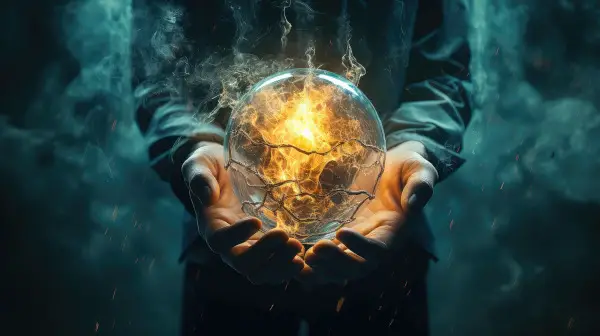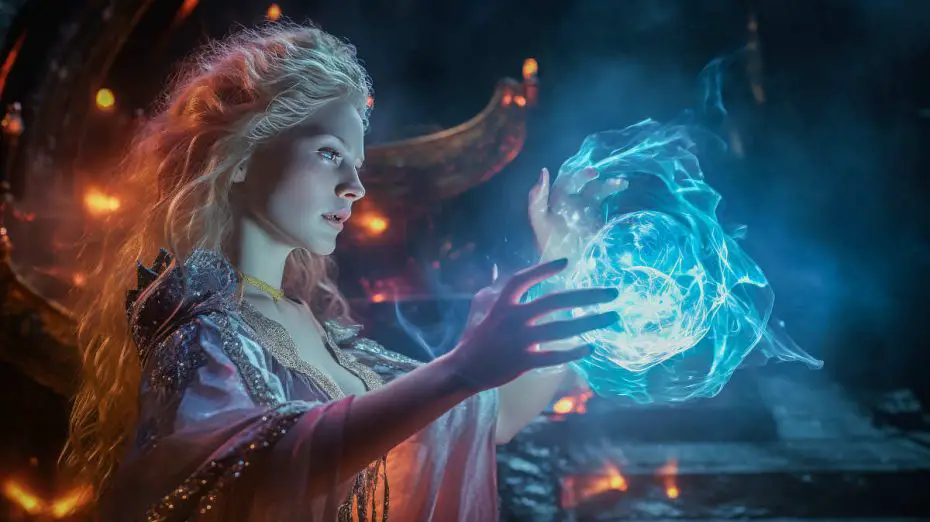The power of imagination is much greater than most people realize. Mental magic is more than just daydreaming; it is the basis for creation itself. The subtle energies that affect your life and environment are shaped by every thought and vivid image you create in your mind.
Elementals are intelligent forces that can be created by a trained mind using imagination. These creatures are not arbitrary or coincidental. They are purposefully created with a structure, a purpose, and a will that the magician instills. Like a craftsman, your imagination transforms unformed energy into living things that can act on your behalf.
When imagination is paired with determination and concentration, it can be a very powerful tool for creativity. It enables you to create enduring forces as well as transient ones that can impact your inner and outer worlds. The first step to unlocking this potential is becoming proficient in visualizing and confidently controlling your mental images.
Why the Mind is the True Gateway to Magical Creation
The mind is the seat of true magical power because it governs both imagination and will. While emotions and instincts might spark actions, it is the mind that directs and shapes energy into tangible outcomes. Every magical act starts first as a thought — an idea carefully cultivated in the mental plane.
Magicians who understand the mind’s power know that their mental creations can cross into the astral and even the material world if fueled with enough clarity and intent. This is why deliberate control of thoughts is critical. Without discipline, the mind produces chaotic forms like larvae, feeding on fear, anger, or desire. But with discipline, it creates elementals — intelligent, obedient forces that fulfill specific tasks.
The mind acts as a bridge between the infinite possibilities of spirit and the physical reality we live in. Those who can consciously shape their mental sphere are able to influence both themselves and the world around them in profound ways.
Mastery of the mind is mastery of creation itself.
What Are Elementals?
Elementals are not ordinary thoughts floating aimlessly in your mind. They are intelligent servants, deliberately created by the magician with a clear task and purpose. Unlike fleeting ideas, elementals are charged with vitality and designed to act independently within the mental plane.
Creating an elemental begins with intense imagination. You shape a specific form, give it life through your willpower, and program it with a direct command. These intelligent forces can perform a wide range of functions — from strengthening a person’s memory to influencing emotions or even attracting success in business.
Because they are born from the concentrated efforts of thought, imagination, and will, elementals are far more potent than random mental chatter. They act as loyal agents, operating silently and efficiently to bring about the desired effects. When crafted properly, they serve without question, often working even when the magician’s attention has shifted elsewhere.
How Elementals Differ from Natural Spiritual Forms
Unlike naturally occurring spiritual beings, elementals are entirely human-made. They don’t evolve over time or originate from a divine source. Instead, they exist because someone deliberately created them with specific intentions.
Natural spiritual entities, such as angels or nature spirits, have their own consciousness and purpose within the universe. They are not dependent on human thought for their existence. Elementals, however, owe their life and mission to the will of the magician. They are shaped, named, and directed according to human desire.
Another key difference is control. A natural spirit acts according to its own laws and nature. An elemental, by contrast, operates under strict orders. Its existence is bound by the instructions it receives at the moment of its creation — including how long it should live and what it should accomplish.
Understanding this distinction is crucial for anyone looking to practice mental magic safely and effectively. Elementals are tools, powerful and obedient, but they must be handled with responsibility and clear intent.
The Four Golden Rules for Creating Elementals
Rule 1: The very first step in creating an elemental is forming its vessel — the shape it will inhabit. This is done purely through the power of imagination. A magician must vividly picture the desired form, making it as real and detailed as possible in their mind’s eye.
The shape of the elemental should match the goal it is intended to achieve. For example, if the purpose is to inspire mental clarity, a bright, glowing orb might be a fitting form. If the task involves protection, a sturdy shield or vigilant guardian figure could be more appropriate. The clearer and more lifelike the image, the stronger the elemental’s foundation becomes.
Intense concentration during this stage is critical. The more effort and emotion poured into the visualization, the more robust and effective the elemental will be once it is set free to act.
Rule 2: Once the vessel is shaped, it must be given a name. In the magical universe, nothing can exist without a name. The act of naming is what anchors the elemental into existence and connects it firmly to the magician’s will.
The name should be short, easy to remember, and resonant with the elemental’s task. For instance, an elemental meant to enhance communication might be named “Voxa,” symbolizing voice and clarity. Naming also serves a practical purpose: it allows the magician to summon, recharge, or dismiss the elemental whenever needed.
Without a name, the elemental would remain incomplete, lacking the essential link that binds it to its creator’s intent.
Rule 3: After shaping and naming the elemental, the next step is to program it with clear, strong instructions. This is where the magician’s willpower takes center stage.
Commands must be given in a direct, present-tense form. There should be no room for ambiguity. Instead of saying, “You should help,” the magician must command, “You help strengthen John’s memory until it becomes sharp and reliable.” The more precise the instruction, the better the elemental understands its task.
Authority in giving commands is essential. An uncertain or hesitant mind weakens the elemental’s effectiveness. Speaking internally or mentally with firmness, as if giving an order to a trusted agent, ensures that the elemental receives the programming it needs to perform flawlessly.
Rule 4: An elemental needs clear boundaries. Defining how long it should exist and what event marks the completion of its mission prevents it from becoming unstable or lingering unnecessarily.
The magician must fix both the goal and the duration. For example, “You continue to work until John’s memory improves to the desired level, then you dissolve back into the universal light.” Setting a clear end-point protects both the magician and the elemental, ensuring the energy is released appropriately once the task is done.
By defining the lifespan clearly, the magician avoids potential complications and maintains full control over the mental forces at play.
A Step-by-Step Guide to Bringing an Elemental to Life
The creation of an elemental starts by imagining an infinite ocean of bright, radiant light. This vast sea represents the pure, living energy from which all mental forms can be drawn.
The magician immerses themselves mentally into this ocean, feeling surrounded and filled by this vibrant, luminous substance. The visualization should be as vivid and tangible as possible, as if one is floating inside a living, breathing field of light. This mental environment becomes the raw material for shaping the elemental.
Condensing Energy into a Radiant Sphere
From the endless ocean of light, the magician begins gathering energy, mentally drawing it together into a single point. With focus and steady will, the light is compressed into a small but dense ball, roughly the size of 12 to 20 inches in diameter.
This ball of light should resemble a miniature sun — brilliant, powerful, and pulsing with condensed energy. The act of condensing strengthens the elemental’s form, preparing it to be infused with intention and direction. The more tightly packed and vibrant the sphere, the more powerful and stable the resulting elemental will be.
Imbuing Your Elemental With Purpose and Power
Once the sphere is fully formed, the magician breathes life into it by impressing it with a clear, unwavering purpose. Using both imagination and strong willpower, the intended task is firmly embedded into the sphere.
For example, if the goal is to improve someone’s memory, the magician imagines the sphere radiating the qualities of sharpness, clarity, and rapid recall. Along with this visualization, a direct mental command is issued, clearly instructing the elemental about its mission and expected results.
This step is crucial. The elemental must feel charged with energy, focused with purpose, and infused with the certainty that it will accomplish the task without fail.
Releasing It Into Action: When and How to Let Go
After the elemental is formed, named, and programmed, it must be set free to act independently. The magician mentally detaches from the creation, breaking the link as if releasing a balloon into the sky.
At the moment of release, it’s important to stop thinking about the elemental entirely. Dwelling on it only keeps it tied to the magician’s mind, limiting its freedom and effectiveness. Some magicians use a small physical gesture, like a simple wave or nod, to symbolically mark the release.
The elemental now operates within the mental sphere of its target, carrying out its task until the goal is achieved. When the task is complete, it dissolves back into the ocean of light, fulfilling the life cycle set by its creator.
Related reading: The Ancient Wisdom of the Elements: The Blueprint of Existence – Opens in new tab
Recharging and Strengthening Your Elemental
Sometimes, an elemental may need a boost to maintain its effectiveness, especially if the task it was given is long-term or particularly demanding. To recharge it, the magician simply calls it back by its given name, summoning it mentally from wherever it is working.
Upon its return, the magician visualizes the elemental clearly, once again placing it into the ocean of light. Here, the magician accumulates fresh, vibrant energy around it, condensing and intensifying the sphere just as in the original creation. Along with the renewed energy, the magician can reinforce the elemental’s original mission with fresh focus and willpower.
After the recharging process, the elemental is released once more to continue its work, now stronger and more dynamic. This simple practice of calling back, re-energizing, and re-sending the elemental ensures it maintains peak efficiency and does not weaken over time.

Recognizing the Signs of a Successfully Working Elemental
A well-crafted elemental shows clear, observable signs in the mental or physical world, depending on its assigned task. If created to sharpen someone’s memory, for instance, you may notice the person recalling information more quickly, speaking more confidently, or learning with ease.
Another sign of a successful elemental is a sense of detachment from it. Once released, the magician should no longer feel mentally connected or worried about its performance. A properly created elemental operates independently, without constant attention or reinforcement unless recharging is specifically needed.
Occasionally, the magician may intuitively sense the elemental’s activity or the shift it is producing in the target’s mental sphere. These subtle indicators affirm that the elemental is alive, active, and fulfilling the mission it was assigned.
Keeping a watchful but relaxed mindset allows the magician to appreciate the elemental’s work without interfering, trusting the process set in motion through imagination, willpower, and focused intent.
Related reading: Unlocking the Secrets of Astral Travel: A Guide to Conscious Separation – Opens in new tab
The Dark Side of Uncontrolled Thought: Understanding Larvae
When emotions are left unchecked, they do more than cloud judgment — they create energetic entities known as larvae. Every surge of fear, anger, grief, or hatred releases mental material into the unseen world. Strong emotions act like a forge, shaping this raw material into living thought-forms.
Unlike consciously created elementals, larvae are born unconsciously, shaped entirely by emotional chaos. They take on symbolic forms connected to the nature of the emotion that birthed them. For example, fear might form a shadowy figure, while hatred could shape itself into a piercing dart. These forms live in the mental sphere, influencing both the creator and their environment without their awareness.
The Everyday Creation of Mental Parasites
Every person, trained or untrained, young or old, produces larvae without realizing it. This happens during intense emotional experiences — a sudden shock, an outburst of jealousy, a lingering sadness. Each instance projects mental matter outward, which then organizes itself into a larva.
These mental parasites don’t just linger in the background. They actively affect mood, thought patterns, and behavior. A person filled with anger, for example, may find themselves constantly provoked into new arguments, not realizing that their own larvae are helping stir the emotions.
In highly sensitive or emotionally charged individuals, larvae are created more quickly and grow much stronger. Left unchecked, they can drain mental energy, weaken the nerves, and even attract similar emotional disturbances from others, fueling mass hysteria or group panic.
Larvae survive by feeding on the same emotional energy that created them. When you repeatedly focus on the original source of emotional disturbance, you unknowingly feed these entities, allowing them to grow denser and more powerful.
The stronger a larva becomes, the more it influences your thoughts, constantly trying to draw your attention back to its source of life. It whispers reminders of old fears, rekindles anger over past events, and deepens feelings of sorrow. In time, a well-fed larva can develop a survival instinct, doing everything it can to maintain its existence.
This dangerous cycle can lead to serious consequences. Strong larvae can cause mental instability, emotional exhaustion, and in extreme cases, lead to conditions like paranoia or depression. Mastery over thoughts and emotions is not just a spiritual exercise — it is a critical protection against becoming enslaved by the very energies you unconsciously create.

Protecting Yourself Against the Dangers of Larvae
The most effective defense against the dangers of larvae is mastering your own mind. Thought control is not just about having positive thinking; it’s about consciously choosing which emotions you allow to grow and which you refuse to nourish.
Every time a strong negative emotion arises, you have a choice. If you indulge in fear, anger, or sorrow, you give life and strength to mental parasites. But by observing your thoughts calmly and refusing to attach energy to destructive feelings, you prevent larvae from forming in the first place.
A daily habit of self-observation strengthens this control. By becoming aware of your inner state, you can quickly catch emotional surges before they have the chance to create harmful mental forms. Regular practices like mindfulness, mental discipline exercises, and even short periods of quiet reflection help build a strong, guarded mental space where only your chosen thoughts thrive.
Healing and Dissolving Unwanted Mental Formations
If larvae have already formed, it’s not too late to dissolve them. Healing begins by withdrawing attention from the emotions that created them. Without a constant supply of emotional energy, larvae begin to weaken, lose their density, and eventually disintegrate.
Visualization is a powerful tool in this process. Imagine the larvae being engulfed by pure, radiant light from the universal ocean, breaking apart into harmless energy and returning to the source. Strong feelings of forgiveness, acceptance, and inner peace act like a cleansing fire that burns away negative formations.
In severe cases, where mental parasites have gained significant strength, more intense mental practices may be needed. These could include deep meditations, ritual cleansing, or working under the guidance of someone trained in mental mastery.
The key is consistent action: starve the larvae by refusing to feed negative thoughts, and actively cultivate emotional states that nourish strength, clarity, and joy.
Check out our recommendations at “Occult Bookshelf” and many free resources at our “Free Library“
Phantoms and Their Subtle Influence on Reality
Phantoms are created when imagination and emotion repeatedly give life to a mental picture. Unlike larvae, which are born from raw emotion, phantoms arise from the persistent evocation of an idea or fantasy. Over time, this image becomes so charged with energy that it takes on a life of its own within the mental and astral planes.
These living shadows often mirror the creator’s strongest beliefs or fears. A person convinced they are being cursed, for example, might create a phantom of a dark figure that seems to follow them. Another who idealizes love or success could unknowingly craft a phantom that influences their emotions and decisions.
The repeated focus and emotional charge strengthen these mental constructs, making them more real to the person than the external world itself. Over time, a phantom can affect not only the creator’s mental state but also their physical health, relationships, and sense of reality.

The Tragic Power of Phantoms Over the Mind
Once a phantom gains enough strength, it can begin to dominate the mind that created it. What starts as a harmless fantasy can evolve into a powerful, independent force, constantly feeding on the attention and emotions of its creator.
Victims of strong phantoms often experience vivid dreams, hallucinations, or a persistent sense of being watched or manipulated. In extreme cases, the phantom can drive a person to anxiety, paranoia, or even self-destructive behavior. The mind, under the phantom’s subtle influence, may interpret ordinary events as confirmation of the fantasy, trapping the individual in a painful cycle.
Phantoms thrive in secrecy and emotional turmoil. The more the victim resists outwardly but fears inwardly, the stronger the phantom becomes. Without intervention — either through strong mental discipline or help from someone skilled in dissolving mental creations — these living shadows can lead to deep psychological harm.
Understanding phantoms is crucial for maintaining sovereignty over one’s mind. Recognizing when a fantasy has gone too far and reclaiming mental control can prevent these powerful shadows from taking hold.
Examples of Phantom Creation
One of the clearest examples of phantom creation happens when fear and suspicion are left unchecked. Imagine someone encountering a stranger who, by pure coincidence, has a stern look or unusual behavior. If the individual is emotionally excitable or prone to suggestion, a seed of fear is planted. They may start believing that this stranger is a threat, perhaps even a black magician.
The more attention and emotional energy the person gives to this idea, the more vivid and detailed the mental image of the persecutor becomes. Small accidents, unlucky days, and misunderstandings are all attributed to the supposed enemy. The fear is fed continuously, and eventually, the person might even begin seeing the imagined persecutor in dreams or sensing their presence in daily life.
Over time, the phantom becomes so dense that it feels almost tangible, influencing the victim’s thoughts, emotions, and even health. What started as a fleeting fear turns into a living shadow that dominates the mind. Sadly, without recognizing that the danger is self-created, the victim may spiral into mental instability, convinced they are truly under attack.
The Dangers of Love Phantoms and Erotic Obsession
Another tragic form of phantom creation centers around unfulfilled desire and obsession. A person deeply in love but unable to satisfy their emotional or physical needs may begin crafting a phantom tied to their passion. This can happen through the idealization of a real person, a photograph, or even a fantasy figure.
At first, the phantom appears harmless — manifesting as dreams or romantic daydreams. However, as the longing intensifies, the phantom grows stronger, feeding on the individual’s emotional and sexual energy. It starts appearing more vividly in dreams, offering comfort or arousing intense feelings.
With each interaction, the victim’s willpower weakens. Their emotional balance deteriorates as the phantom demands more attention and drains more vital energy. In severe cases, it can lead to depression, nervous breakdowns, and even physical health problems.
Without intervention or a shift in emotional focus, the victim becomes trapped in a cycle where the phantom replaces real human connection. Historically, these experiences gave rise to stories of succubi and incubi — seductive spirits feeding on the life force of their victims.
Recognizing these dangers early and re-centering the mind on reality and healthy relationships is key to avoiding the devastating grip of love phantoms.
Related reading: Beyond the Shadows: How Occultism Shaped Politics, Science, and Social Change – Opens in new tab
Phantasms: The Shadows of the Deceased
When a person dies, their spirit passes into a higher state of existence, often called the “world beyond.” Without a mediating substance, beings from this realm cannot easily interact with the material world. However, strong memories, grief, and longing from the living can unintentionally create powerful mental images of the deceased.
These emotionally charged images become phantasms — living thought-forms animated by the love, sorrow, or obsession of those left behind. Each act of mourning, every remembrance, adds energy to these shadows, allowing them to linger and sometimes even manifest as visions, sensations, or dreams.
Many so-called ghost sightings, spiritual encounters, or even mediumistic communications are, in fact, interactions with these phantasms rather than the true spirit of the departed. Because they are created by the emotional energy of the living, they often mirror the expected personality traits or messages the bereaved hope to receive, rather than conveying genuine wisdom or presence from beyond.

Separating True Spiritual Contact From Illusion
While phantasms are powerful, they are not the same as genuine contact with a spirit. True spiritual communication happens on a higher plane and requires a trained magician who can operate consciously in the fourth state of aggregation, working directly through the akasa principle.
Authentic spirit contact is rare and deliberate, requiring clear, controlled conditions. It does not rely on random emotional energy or uncontrolled longing. In contrast, phantasms are numerous, easily created, and thrive in environments filled with strong emotion and suggestibility.
One clear sign of dealing with a phantasm is inconsistency. Phantasms often give conflicting, vague, or repetitive information, reflecting the emotional confusion of the living rather than true spiritual insight. Additionally, true spirits do not seek to drain energy, cause fear, or demand constant attention — behaviors often associated with phantasms.
Recognizing the difference protects the seeker from self-deception and emotional harm. Understanding that many “ghostly” experiences are self-created allows individuals to process grief more healthily and seek true spiritual growth with clarity and grounded awareness.
Navigating the Mental World With Wisdom and Willpower
Working with the powers of the mind brings incredible opportunities — but it also demands great responsibility. Every thought, every strong emotion, and every act of imagination has the potential to shape unseen forces. A conscious creator understands that mental energy is never neutral. It either builds beneficial forces like elementals or unintentionally creates harmful ones like larvae and phantoms.
Taking responsibility means practicing mindfulness daily. It requires observing thoughts before they crystallize into forms and emotions before they ripple outward. The magician, or any mindful individual, learns to ask: Is this thought building something I want in my life?
True mastery of the mental world is not just about power over others or external success. It’s about self-mastery — ensuring that the forces you unleash into the world are intentional, noble, and aligned with higher principles. With every conscious act of creation, you strengthen your own mental clarity and open doors to deeper spiritual development.
The Golden Rule: Love Guided by Strong Will
In the world of magical practice, love alone is not enough. Without strong willpower, love can become unfocused and easily manipulated by mental forces. The true magician lives by a higher standard: “Love under a strong will.”
This means that all creations of the mind should be guided by compassion, wisdom, and a steady, unwavering focus. It is love that inspires the desire to create good, but it is willpower that shapes it into effective, lasting results.
Practicing this principle ensures that the magician’s work is not only powerful but also ethical and harmonious. It shields against the dangers of unconscious creation and guarantees that the energies set in motion uplift, rather than harm, the creator and the world around them.
By marrying love with will, the conscious creator navigates the vast mental universe with confidence, balance, and true mastery.
Final Thoughts
The mind is not just a tool for thinking — it is a living force capable of shaping reality. Every thought, every emotion, and every act of imagination carries the seeds of creation. Awakening to this truth transforms the way you see yourself and the world around you.
With understanding and practice, you realize that you are never truly powerless. You have the ability to create forces that serve your highest good, heal your mind, and influence your environment in positive, lasting ways. This awakening is not about gaining control over others, but about mastering yourself, your inner world, and your destiny.
Recognizing the mind’s true power is the first step toward living consciously and deliberately, no longer a victim of random thoughts or runaway emotions.
Every moment, you are creating — either light or shadow. By choosing to create with love, clarity, and strong will, you bring light not only into your own life but also into the lives of others.
When you consciously shape your mental world with noble intentions, you empower yourself to rise above fear, negativity, and confusion. You dissolve harmful forces before they take root and instead give life to creations that inspire, protect, and uplift.
Choosing light is a daily commitment, a path of inner discipline and profound compassion. It is the essence of true magical practice — the art of creating in harmony with the highest forces of existence.
This article is based on Franz Bardon’s book: Initiation Into Hermetics (Aff.link)
Check out our recommendations at “Occult Bookshelf” and many free resources at our “Free Library“
Stay in Touch
 Join our newsletter by using the forms on this website or click here!
Join our newsletter by using the forms on this website or click here! Follow us on Google News
Follow us on Google News Follow us on Facebook
Follow us on Facebook
Featured image by Friedrich Teichmann from Pixabay










